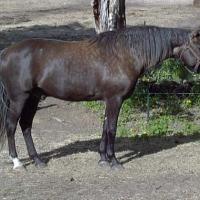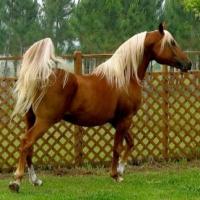Modifiers
Modifiers change the appearance of the coat color. They are similar to dilutions but have different effects. Modifiers include: Agouti (Bay) Gray Sooty Pangare Flaxen

Photo by Audrey C. Crosby
Agouti (Bay) is the most common modifier in the domestic horse population. It restricts the production of black pigment to the points, leaving the body red in color, but the points black. Agouti does not affect chestnut horses, but can be carried by them, and passed on to their offspring. It is theorized that there are several different alleles of agouti, including:
Classic Bay (A): Classic Bay is a horse with a red brown body color and black points.
Wild bay Arabian gelding HA Cytech. Photo donated by Jennifer Whittaker of Mystic Rose Arabians
Wild Bay (A+): A wild bay looks almost the same as a classic bay, but the points on a wild bay are noticeably shorter, usually ending around the ankles. They may even be absent altogether. The body color is usually lighter then a classic bay and the mane and tail may be prone to bleaching or composed of lighter hairs.
Seal Bay (At): Seal Bays or Browns are very dark and generally have a black, or nearly black, body with red or tan around the nose, eyes, and flanks. At present, Pet DNA Services of AZ offers a test for (At) but because they have not published their research, there is still some debate. More Examples of Bay
class="clear">
Gray is a dominant modifier that changes the coat color to white over the years. It can affect any color or color combination. Gray horses are often born with a fully colored coat, like an adult horse: i.e. a bay foal would be born with black legs, rather than pale colored legs that come in black after the foal shed. Other signs that experienced breeders look for are: chestnut foals who are born with dark skin, instead of pink hued skin; and telltale white hairs - even one - in the eyelashes or around the eyes. Graying often begins on the face, creating "gray goggles" around the eyes of foals. But horses can begin to gray on almost any part of the body. Some horses, in particular very dark or black horses, have been observed to begin graying as late as nine years old. Some foals are born having already begun the graying process. Grey horses will have dark eyes and skin (if another dilution, modifier or white pattern has not changed them). More Examples of Gray
class="clear">
Sooty (sometimes called smutty) is a modifier that causes black hairs to be mixed into the coat. Generally, the effect is as if someone had dumped a bucket of soot over the horse's head and back. It seems to act as a form of countershading. The dark pigment can also be distributed evenly throughout the coat or concentrated on the mane, tail, legs or other parts of the body. It may express itself as smudges, patches, striping, spots, or dappling. It can mimic primitive markings. It is believed to create dark bays, possibly dark chestnuts, as well as dark palominos and buckskins. There is debate over whether it causes liver or black chestnuts, and seal bays or browns. Sooty tends to vary seasonally and is susceptible to bleaching and the general condition of the coat caused by grooming, stabling and nutrition. It is not known at this time what causes sooty. More Examples of Sooty
class="clear">
Freddy is an unregistered 10 year old Exmoor pony gelding belonging to Edinburgh University Exmoor Pony Trekking Section
Pangaré (also called mealy) is a modifier that lightens the coat of chestnut and bay horses along the flanks, belly, inner legs, at the muzzle and around the eyes. It often presents as flaxen in chestnut horses. It is believed to not express on black horses. The inheritance of pangaré is not understood.More Examples of Pangare
class="clear">
Flaxen is a modifier that lightens hairs in the mane and tail of chestnut horses. It may also affect the lower legs. It is sometimes confused with palomino or silver. It may vary in its effect, and appear or disappear as the horse ages. The inheritance of flaxen is not understood. More Examples of Flaxen


